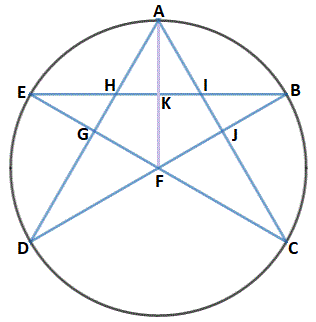An Irregular Pentagram
An irregular pentagram that can be inscribed in a unit circle has four congruent angle tips and a fifth angle tip that is twice as big as one of the others.
If the area of its inner pentagon is q p , where p and q are square-free integers, find p + q .
The answer is 9.
This section requires Javascript.
You are seeing this because something didn't load right. We suggest you, (a) try
refreshing the page, (b) enabling javascript if it is disabled on your browser and,
finally, (c)
loading the
non-javascript version of this page
. We're sorry about the hassle.
2 solutions
Since the sum of two sets of exterior angles of the interior pentagon is 2 ⋅ 3 6 0 ° = 7 2 0 ° , and the sum of the angles of the five triangles around it is 5 ⋅ 1 8 0 ° = 9 0 0 ° , the angle tips have a sum of 9 0 0 ° − 7 2 0 ° = 1 8 0 ° .
Letting x be the measurement of one of the four congruent angle tips, the fifth angle tip is 2 x , which means 4 x + 2 x = 1 8 0 ° , so that x = 3 0 ° . Therefore, the five angle tips are 3 0 ° , 3 0 ° , 3 0 ° , 3 0 ° , and 6 0 ° .
Let the pentagram be labelled as follows:

By symmetry, since ∠ D A C = 6 0 ° , then ∠ F A C = 3 0 ° . By the inscribed angle theorem, since ∠ A D B = 3 0 ° , then ∠ A F B = 6 0 ° . As radii, A F = B F = 1 . Solving △ A F J , ∠ A J F = 9 0 ° , F J = 2 1 , and A J = 2 3 , and solving △ B K F , ∠ B K F = 9 0 ° and K F = 2 1 , and solving △ A K I , A K = A F − K F = 2 1 and K I = 6 3 .
The area of △ A F J is then A △ A F J = 2 1 ⋅ 2 1 ⋅ 2 3 = 8 3 , and the area of △ A K I is then A △ A K I = 2 1 ⋅ 6 3 ⋅ 2 1 = 2 4 3 .
By symmetry, the area of the inner pentagon is A F G H I J = 2 ( A △ A F J − A △ A K I ) = 2 ( 8 3 − 2 4 3 ) = 6 3 .
Therefore, p = 3 , q = 6 , and p + q = 9 .
The pentagram has four vertex angles of 3 0 ∘ and one vertex angle of 6 0 ∘ . Its inner pentagon is made up of four congruent right-angled triangles with perpendicular sides of lengths 2 1 and 2 3 1 , and hence the pentagon has area 4 × 2 1 × 2 1 × 2 3 1 = 6 3 making the answer 3 + 6 = 9 .